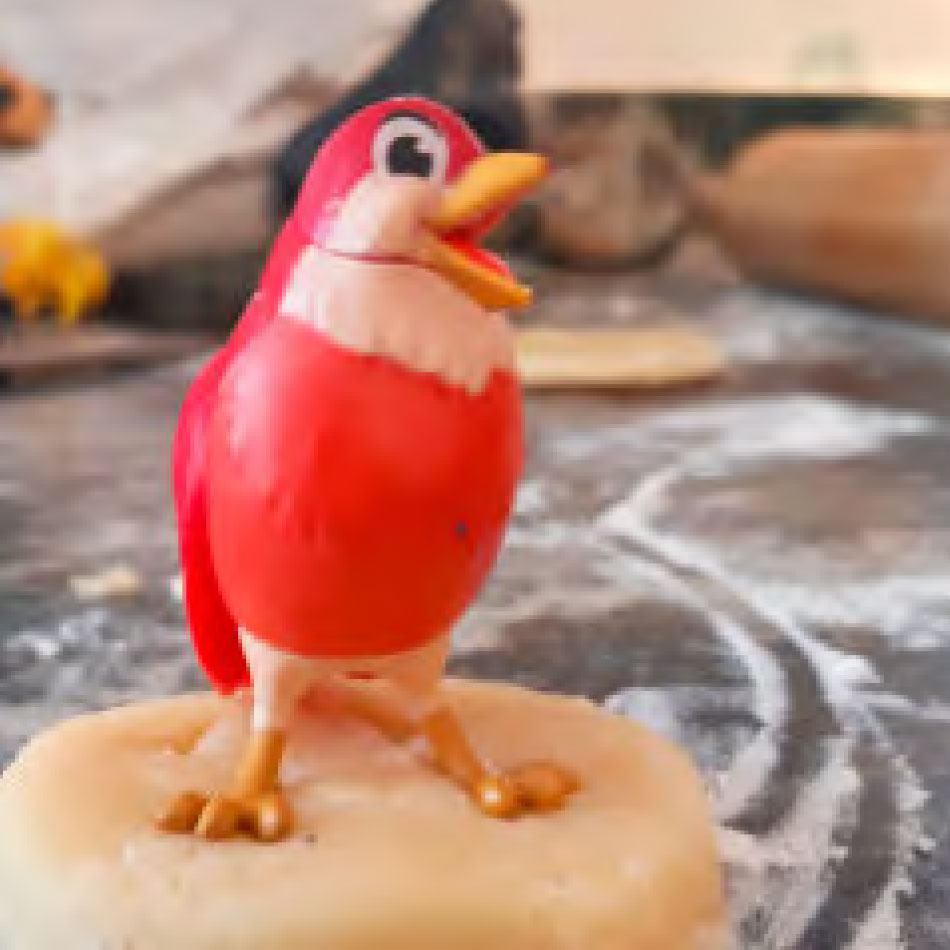Animal Track Cookies
Enjoy a tasty treat and learn how to identify animal tracks in the snow
- All
- Things to Make
- Fun With Food

What you’ll need:
Ingredients
- 2 cups flour
- 2 tsp baking powder
- ½ tsp salt
- ½ cup butter (softened)
- 1 cup sugar
- 2 eggs (beaten)
- ½ cup milk
- ½ tsp vanilla
- Chocolate spread or jam
- Icing sugar (optional)
Tools
- An oven
- Two mixing bowls
- A rolling pin
- A baking sheet
- Parchment paper
- A round cookie cutter or other round tool, like a glass
- Plastic toy animals (cleaned and dried)
- Oven mitts
- A small spoon or butter knife
- A sieve (optional)

Activity setup:
- Preheat the oven to 350 °F.
- Combine the flour, baking powder and salt. If you have a sieve, use it to sift the ingredients together.
- In a separate bowl, combine the softened butter and sugar. Mix until light and fluffy, and then add the two beaten eggs, milk and vanilla.
- Gradually combine the flour mixture with the butter mixture until the ingredients are well combined. The dough should be soft; try not to overmix.
- Refrigerate the dough for two hours until firm, or leave it in the fridge overnight.
- On a lightly floured surface, roll out the dough to about 5 mm thick.
- Use a cookie cutter or other round tool, like the top of a glass, to cut the dough into rounds. Place the rounds on a baking sheet lined with parchment paper. Re-roll the scraps and cut more rounds until you’ve used up all the dough.
- Take a toy animal and lightly dust its feet with flour. Then, press one or both of the toy’s feet into a round of dough. Repeat this step on all of your rounds using different toy animals.
- Place your baking sheets in the oven and bake your cookies for about 10 minutes at 350 °F. Be sure to ask a grownup for help with this step! When the underside of the cookies look dry and the tops have started to brown slightly, the cookies are done. The cookies should still be soft when you take them out of the oven.
- Carefully remove the baking sheets from the oven—don’t forget your oven mitts—and let the cookies cool for a few minutes until they firm up. Then, move the cookies to a cooling rack.
- Using a small spoon or butter knife, carefully add a small amount of chocolate spread or jam to each footprint. To add a light dusting of “snow,” use your sieve to sprinkle icing sugar on your cookies.
- Enjoy your cookies!

What do animal tracks tell us?
Animals spend a lot of time searching for food and shelter. They often leave imprints in the ground when they walk around, especially in moist, sandy or muddy areas. These imprints are called tracks. In the winter time, animals leave their tracks in the snow.
Biologists study animal tracks to learn more about the habitat and behaviour of a particular species, including what they like to eat. This information is used to support the conservation and protection of natural areas.
To learn about the animal that left a track behind, a biologist might ask:
- How many toes are visible in the track?
- Are there any visible claws?
- What’s the size of the footprint, and how long is the animal’s stride?
- What type of gait does the track indicate? Did the animal walk, trot, hop, gallop or move another way?
A closer look at different animal tracks
The next time you’re outside playing on a snowy day, see if you can spot any animal tracks before you scoop up the snow to build a snowman or fort. Here are some tips to help you identify different animals from their tracks:
Rabbits and squirrels have four front toes and five hind (back) toes. These animals both leave behind similar tracks, since both species have small front feet and larger hind feet. There are some differences, though: The large hind feet in rabbit tracks tend to be at an angle, while their front feet are usually staggered. The front feet in squirrel tracks are usually side by side.
Raccoons have five toes on both their front and hind feet. Due to the shape of their toes, raccoon tracks are similar to a human hand print—though much smaller!
Ducks, geese, swans and otters have webbing between their toes. This webbing, which is visible in the tracks they leave behind, helps them pad through water.
Song birds, crows, doves and hawks have three toes pointing forward and one long toe pointing backward for support. They leave behind tracks that are shaped like forks. The tracks of these different species are difficult to distinguish, except by size.
Foxes, wolves, coyotes and dogs have four toes on both their front and hind feet. Their tracks often have visible claw marks. This is one difference between canine prints and cat prints. Although cats also have four toes, they retract their claws when they walk.
Beavers and bears have five toes on both their front and hind feet. Beavers have webbing between the toes on their hind feet, which is usually visible in their tracks. Bear tracks also tend to be much bigger than beaver tracks!
Deer, elk and moose have two distinct toes on their feet. These are known as hooves. Although all of these tracks look similar, they differ in size. Deer have the smallest tracks of this group (about 8-9 cm), while moose have the largest (13-18 cm). You can find white-tailed deer tracks throughout Ontario and in the northern boreal forest, where you would also find tracks from moose and some North American elk. Because deer and elk usually travel in herds, you would likely find many tracks in one place.
Did you know?
- Polar bears make the largest track of any mammal in North America. Their hind feet can be over 33 cm long! Scientists can isolate polar bear DNA by taking a small sample of snow from their track.
- The American pygmy shrew, a type of rodent, has the smallest track of any mammal in North America. Their hind feet can be as small as 8.5 mm! This species was discovered near Parry Sound, Ontario by naturalist William Cane in 1831.